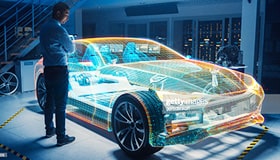The future of connected cars with 5G connectivity
Introduction
In recent years, there has been a substantial growth in the usage of connected cars; these vehicles are equipped with a number of sensors that may collect data about the vehicle's performance, position, and other critical parameters. This data is subsequently transferred to a central machine for processing, where it may be utilised to enhance the performance and reliability of the vehicle. Traditional vehicle tracking and diagnostics systems, on the other hand, have speed, data capacity, and connectivity constraints. This can make gathering and processing real-time data from connected vehicles challenging, limiting the effectiveness of these systems. Furthermore, using traditional cellular networks may result in poor and unpredictable communication, affecting the operation of car tracking and diagnostics systems. Here is where 5G communication technology comes into play, offering a faster and more stable connection capable of enabling real-time vehicle tracking and diagnostics.
Connected cars
Various types of connected vehicle technologies are being pursued and improved.

Table 1: Types of connected vehicle technologies
What does V2X cover?
The basic components of V2X consist of the vehicle (V) and its ability to connect with other Intelligent Transportation System (ITS) stations. V2X comprises transceivers that can be found on vehicles, roadside infrastructure, aftermarket devices, or handheld devices.
What kind of transportation experience can we expect in a V2X world?
Figure 1 shows an aspirational example of what future personal mobility may look like:

Figure 1: Use cases, requirements, and design considerations for 5G V2X (Source: Huawei German Research Center)
1. A user of a vehicle can request a ride through a mobile app.
2. The vehicle self-drives or be controlled by a human or AI from a distance, whilst the user's transportation app communicates with it through a mobile network to customise settings.
3. The vehicle has the ability to drive itself and locate the most suitable group of cars (platoon) for the user's preferences. It can perform maneuvers to join the selected group and can conserve energy by allowing the cars to follow at very short gaps.
4. The vehicle uses two-way navigation to navigate around congested roads by receiving and providing real-time traffic information.
5. The user can take control of the vehicle to exit the highway and drive on a scenic route suggested by the connected navigation system.
6. The vehicle drops off the user at their destination.
7. The vehicle can self-drive to an automated parking lot or to another user.
Challenges relating to omnidirectional antennas and signal strength
Developing a "smart antenna" needs a significant obstacle to overcome: the successful integration of mobile communication with antenna technology. Cable connections transmit signals from a roof-mounted antenna to the onboard electronics, typically in the driver's cockpit. With the increasing demand for bandwidth, the 5G network will use a broader range of frequencies, ranging from 6 GHz to 100 GHz. This means that transmitting signals via cable would result in significant signal loss. As a solution, the electronics and signal processing must be positioned near the antenna, either directly under the roof or within the antenna itself. However, this presents the challenge of the electronics being exposed to varying weather conditions, which can negatively impact their performance and lifespan.
Furthermore, the expansion of the frequency range results in greater radio field attenuation, causing signals to be received only over shorter distances. This poses a problem for omnidirectional antennas, which may fail to receive signals or only accept them to a limited extent. Although this problem can be solved by precisely aligning the antennas, this requires a large number of antennas to be fitted onto devices. Consequently, only antennas facing the transmitter can be used. Additionally, roadside units must be equipped with directional antennas to transmit signals to passing vehicles.
5G and cellular IoT
The 5G technology caters to three main categories of services:
- Enhanced mobile broadband (eMBB): This category lays the foundation for immersive in-car experiences such as augmented reality, high-precision digital maps, and continuous firmware updates. These advanced features will drive the need for higher data bandwidth requirements.
- Ultra-reliable low latency communication (URLLC): This category is crucial for mission-critical functions such as safety systems in vehicles, such as Vehicle-to-Vehicle and Vehicle-to-Infrastructure communications (V2X), and automated driving. These functions require ultra-reliable and extremely low-latency communication to ensure optimal performance and safety.
- Massive machine type communication (mMTC): The numerous sensors found in smart cities, homes, and cars generate a massive amount of data that must be communicated securely via a gateway to remote servers in the cloud hosting remote services and data.
Antenna & wireless technology for 5G
The antennas used for 5G are typically smaller in size compared to those used for previous cellular signals, yet they offer higher precision and lower latency. The 5G technology uses intelligent power switching to optimise beamforming, an active antenna technology that uses directional radio links to selectively and simultaneously provide high bandwidth to mobile devices.
The 5G antennas and wireless modules support massive multiple input-multiple output (MIMO) systems, enabling targeted radio contact between 5G transmitters. The latest 3D and massive MIMO devices have several transmitters and receivers operating within one terminal unit, allowing faster data transmission. Additionally, many 5G antennas are compatible with 4G LTE signals. Whilst most 5G car antennas resemble 4G antennas in appearance, they are typically smaller and slimmer.
5G will enable advanced C-V2X
The application of 5G technology is particularly well-suited for cellular V2X (C-V2X) communication, which enables communication in bi-directionally and can operate up to a range of 1,000 meters by using cloud-based sensor sharing. One of the key advantages of using 5G for C-V2X is its extremely low latency, with a response time of just four milliseconds or less. In contrast, 4G Long-Term Evolution (LTE) standards have a latency of 15 milliseconds or less.
The future of 5G in the connected car
Competing standards are in play for V2X. Two of them are explained in the following content.
IEEE 802.11p
IEEE 802.11p, a Wi-Fi variation, operates in the unlicensed 5.9GHz frequency band and serves as the basis for the original V2X standard. This technology extends V2X communication beyond sensors' line-of-sight, allowing V2V and V2I use cases such as collision warnings, speed limitation alerts, electronic parking and toll payments. IEEE 802.11p does have the advantage that it's not dependent on cellular network coverage. (This is determined by onboard units (OBUs) and road-side units (RSUs)). It has short-range capabilities (under 1km), low latency (~2ms), and is highly reliable, making it resistant to extreme weather conditions.
Cellular V2X
C-V2X, or Cellular V2X, is a developing alternative to IEEE 802.11p. C-V2X has two operational modes, which cover the majority of eventualities. The first is low-latency C-V2X Direct Communications over the PC5 interface on the unlicensed 5.9GHz band, which is intended for active safety messages such as immediate road hazard warnings and other short-range V2V, V2I, and V2P situations. This mode is similar to the current IEEE 802.11p technology, which also operates in the 5.9GHz band.
The second mode is communications over the Uu interface or UMTS air interface on a regular licensed-band cellular network, which can handle V2N (Vehicle to Network) use cases such as infotainment and latency-tolerant safety alerts about longer-distance road hazards or traffic conditions. IEEE 802.11p can only match this mode by establishing ad hoc connections to roadside base stations.

Figure 2: Network communications for latency tolerant use cases
The following table 2 shows C-V2X Technical Advantages over IEEE 802.11p

Table 2: C-V2X technical advantages over IEEE 802.pp
Several development kits, software, and company modules are available to execute design, development, and also projects on 5G Technology. Newark has partnered with many different suppliers catering to a wide range of industrial 5G components portfolio, such as Wireless module adaptors, Antennas, connectors, RF wireless development kits, Clock- timing development kitsm, IC modules, Debuggers emulators & JTag tool accessories, and interface communication development kits, and display development kits, are available to execute design, development, and projects on 5G Technology.






